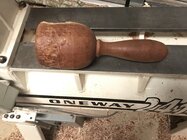Have fun. How long will you class(s) be.
When I taught the beginning bowl class at MD hall in Annapolis it was 8 meetings of 2.5 hours each.
The biggest thing - don’t try to teach them everything at once and don’t teach them things they aren’t going to use in the current class. This is sometimes difficult when you get asked questions. I try to always either answer a question or state when we will get to that in the course. A question that is way off in the weeds- I’ll tell the student to see me after class. Or once in a great while - I don’t know. With multiple classes, I sharpen all the tools in the first classes.
plan a set of exercises
Class 1 - lathe parts, safety, class traditions any lathe running face shields on. Students can’t use the bandsaw.
turn a carving mallet. 3.3x3.5x10 blank usually green wood - tools SRG, 1/2” spindle gouge, parting tool
I have each student do 2 good cuts on the demo lathe then they rough a cylinder.
Then make a parting cut to mark the handle section. They then turn beads all along the handle 1/2 spindle gouge
Smooth the handle SRG. Turn coves on the handle section, smooths the handle with the SRG
Finish turn the mallet
This gets them used to the lathe an simple tools
View attachment 66452
Class 2 rough turn a bowl 8-10 “ disc 3-4” high started on a screw.
Bowl gouge, spindle gouge (tenon), round nose scrape
I teach them to sharpen the scraper on a platform
Push cuts, scraping cut
Class 3 rough turn a bowl between centers
Teach them to sharpen bowl gouge with a jig.
Push cuts, scraping cut,
Microwave bowl
Class 4 return dried bowl. Push cuts
Shear scraping with the gouge Some sanding
Class 5 green turn a bowl
Push cut, pull cut, shear scraping
Class 6 Natural edge bowl
Classes 7,8 bowls with individual assistance. Most student turn 10” bowls
If I have a really fast learner- they will turn 3 10” bowls in a class so I give them a 12-13” blank unless they brought their own wood.

